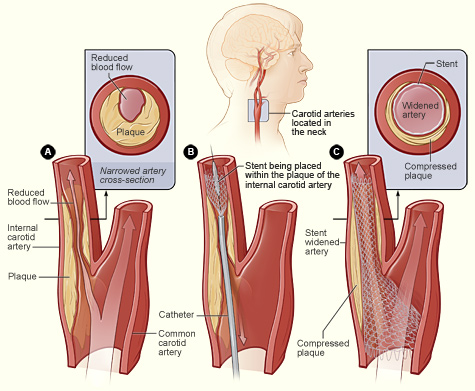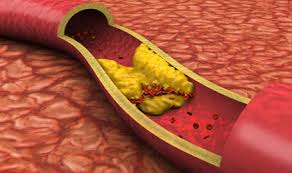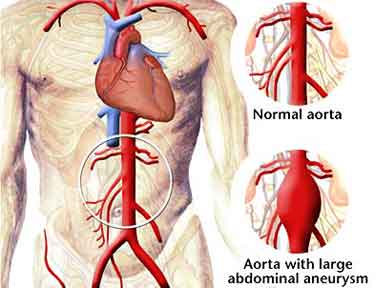
What is carotid endarterectomy ?
Carotid endarterectomy is an operation during which your vascular surgeon removes the inner lining of your carotid artery if it has become thickened or damaged. This procedure eliminates a substance called plaque from your artery and can restore blood flow. As you age, plaque can build up in the walls of your arteries.
Cholesterol, calcium, and fibrous tissue make up this plaque. As more plaque builds up, your arteries narrow and stiffen. This process is called atherosclerosis, or hardening of the arteries. Eventually, enough plaque builds up to reduce blood flow through your carotid arteries, or to cause irregularities in the normally smooth inner walls of the arteries. Your carotid arteries are located on each side of your neck and extend from your aorta in your chest to enter the base of your skull. These important arteries supply blood to your brain.
Carotid artery disease is a serious issue because clots can form on the plaque. Plaque or clots can also break loose and travel to the brain. If a clot or plaque blocks the blood flow to your brain sufficiently, it can cause an ischemic stroke, which can cause permanent brain damage, or death, if a large enough area of the brain is affected. If a clot or plaque blocks only a tiny artery in the brain, it may cause a transient ischemic attack (TIA), also known as a mini-stroke. A TIA is often a warning sign that a stroke may occur in the near future, and it should be a signal to seek treatment soon, before a stroke occurs. To remove plaque in your carotid arteries and help prevent a stroke, your physician may recommend a carotid endarterectomy. Carotid endarterectomy is one of the most commonly performed vascular operations, and is a safe and long-lasting treatment.
What is carotid endarterectomy ?
Before you have carotid surgery, there are a number of tests that need to be done to assess whether you are able to have the operation, and some immediately before the surgery (pre-operative tests). Tests to see whether you are suitable for the operation include:
• Ultrasound scan MRA or a dye X-ray (digital subtraction angiogram) of the arteries
• Blood tests
• ECG (a heart tracing)
• Echocardiogram (an ultrasound test of the heart)
• Breathing test
• CT scan (special X-ray scan) of your brain.
These tests should have been done within a couple of days of your symptoms. If you are fit enough, you will then be offered an operation within two weeks of your symptoms.
Procedure:
Most patients are admitted to the hospital the day before surgery or, in some cases, on the morning of surgery. Small metal disks called electrodes will be attached to your chest. These electrodes are connected to an electrocardiogram machine, which will monitor your heart's rhythm and electrical activity. You will receive a local anesthetic to numb the area where a plastic tube (called a line) will be inserted in an artery in your wrist. An intravenous (IV) line will be inserted in your vein. The IV line will give you the anesthesia during the operation. You will be given something to help you relax (a mild tranquilizer) before you are taken into the operating room.
After you are completely asleep, a tube will be inserted down your windpipe and connected to a machine called a respirator, which will take over your breathing. Another tube will be inserted through your nose and down your throat, into your stomach. This tube will stop liquid and air from collecting in your stomach, so you will not feel sick and bloated when you wake up. A thin tube called a catheter will be inserted into your bladder to collect any urine produced during the operation.
The surgeon will make a cut (called an incision) in the neck to get to the carotid artery. The surgeon places a tube (called a shunt) into the artery above and below the blockage. The shunt lets blood flow around the blockage to nourish the brain. The surgeon then peels the plaque from the inside of the carotid artery. When all of the plaque is removed, the shunt is removed, and the incision in the artery is closed by stitching a patch of fabric (Dacron) or vein into the incision. A carotid endarterectomy can also be done by a technique that does not require blood flow to be rerouted. In this procedure, the surgeon stops the blood flow just long enough to peel the blockage away from the artery.The surgery takes about 1 to 2 hours.
Recovery Time
You can expect to stay in the hospital for about 1 to 3 days, including 1 day in the Intensive Care Unit (ICU). During that time in the hospital, you will need to lie flat and not move your head too much. You may find that your neck aches, and this may last for up to 2 weeks. Try to avoid physically demanding activities for about 1 week. It may take as long as 2 weeks before you are totally healed.
Life after Carotid Endarterectomy
After a carotid endarterectomy, you should limit the fat and cholesterol in your diet. Your doctor may want you to start an exercise program. Other lifestyle changes include quitting smoking, limiting how much alcohol you drink, and controlling your blood pressure and cholesterol levels.

What is abdominal aortic aneurysm (AAA)?
An abdominal aortic aneurysm is an enlargement of the lower part of the aorta that extends through the abdominal area (at times, the upper portion of the aorta in the chest can be enlarged). The aorta is the main blood vessel that carries blood from the heart to the rest of the body. Since arteries are elastic and are filled with blood under high pressure, the wall of the artery may become weakened and distended like a balloon.
The analogy of a bubble in a garden hose would be appropriate in describing an aneurysm. Aneurysms are usually discovered before they produce symptoms, such as back pain, but like the weakened hose, they may rupture if they become too large. Since a ruptured aneurysm is extremely dangerous, causing life-threatening bleeding, aneurysms are best corrected by an operation before this happens.
Aortic aneurysms can develop anywhere along the length of the aorta. The majority, however, are located along the abdominal aorta. Most (about 90%) of abdominal aneurysms are located below the level of the renal arteries, the vessels that leave the aorta to go to the kidneys. About two-thirds of abdominal aneurysms are not limited to just the aorta but extend from the aorta into one or both of the iliac arteries.
Aortic aneurysms often grow slowly and usually without symptoms, making them difficult to detect. Some aneurysms will never rupture. Many start small and stay small, although many expand over time. Some aortic aneurysms enlarge slowly, increasing less than half an inch (1.2 centimeters) a year. Others expand at a faster rate, which increases the risk of rupture. How quickly an aortic aneurysm may grow is difficult to predict.
As an aortic aneurysm grows, some people may notice: -
• A pulsating feeling near the navel, if the aneurysm occurs in the abdomen
• Tenderness or pain in the abdomen or chest
• Back pain
Aneurysms can develop anywhere along the aorta, but most occur in the abdomen and are called abdominal aortic aneurysms. Aneurysms that occur in the part of the aorta that's higher up in your chest are called thoracic aortic aneurysms. Very large or symptomatic aneurysms require treatment. There are two types of surgical treatments for large aneurysms.

This involves the surgeon making an incision to access the abdominal aortic aneurysm. The diseased portion of the aorta is replaced with a graft that acts as a replacement blood vessel. Open surgical repair is a proven procedure that has a good track record and acceptable risks. But it also involves a long recovery period.
Average hospital stay ranges from 5 to 8 days. The time until return to normal activity ranges from 6 weeks to 3 months. As with any operation, open surgical repair has a risk of complications. You will want to discuss them thoroughly with your doctor.
"Endovascular " means "inside or within a blood vessel" -- and that is exactly how a small fabric tube that has metal stents attached to the fabric, called a stent-graft, is introduced into your body and moved into place. First, small incisions are made in each groin to get to arteries that carry blood from the aorta. The surgeon then moves the stent-graft up through these arteries until it is opened inside the diseased portion of aorta.
The stent-graft reinforces the weakened part of the vessel from the inside and creates a new channel through which the blood flows, eliminating the risk of rupture. This procedure usually takes 1 to 3 hours and patients typically leave the hospital in 1 to 2 days. Return to normal activity ranges from 2 to 6 weeks. Like any medical procedure, endovascular repair has a risk of complications. It also involves regular routine follow-up visits with your doctor to evaluate the stent-graft. These regular follow-ups are extremely important and will require CT. Aneurysms are often diagnosed by chance during exams or tests done for other reasons. In some cases, they are found during a screening test for aneurysms. Screening tests help your doctor look for a certain disease or condition before any symptoms appear.

Mr.Gilbert, Knee Replacement, Nigeria
Mr.Gilbert from Aba, Nigeria who came to India for his knee replacement in India.
Mrs. Kalangwa George, Lung Cancer, Kenya
Mrs. Kalangwa George from Mombasa, Kenya who came to India for her Lung Cancer Treatment in India.
Mrs. Elisabeth, Breast Cancer Surgery, Nigeria
Mrs. Elisabeth from Kano, Nigeria who came to India for the Breast Cancer Surgery.
Mr.Tselmeg, Kazakhstan, Spine Surgery
Mr.Tselmeg from Astana, Kazakhstan who came to India for the Spine Surgery
Mr. Stephen Okafor, Spine Surgery, Nigeria
Mr. Stephen Okafor from Onitsha, Nigeria who came to India for the Spine Surgery
Mrs. Asiata Nofiu, Laparoscopic Ovarian Cystectomy , Nigeria
Mrs. Asiata Nofiu from Lagos, Nigeria who came to India for the Laparoscopic Ovarian Cystectomy
Mr. Alhassan Osman, Prostate Treatment, Tanzania
Mr. Alhassan Osman from Mwanza, Tanzania who came to India for the Prostate Treatment
Mr. Okubowa Babatunde , Heart Surgery , Zimbabwe
Mr. Okubowa Babatunde from Harare, Zimbabwe who came to India for the heart hole surgery